Table of Contents
ISRO successfully launches India’s first solar mission, Aditya-L1, via PSLV from Sriharikota which aims to study the Sun from a Halo orbit at L1, focusing on Coronal Heating, Solar Wind, Coronal Mass Ejection, and space weather.
Aditya L1 Mission 2023: The Indian Space Research Organisation (ISRO) is in the process of designing India’s inaugural observatory-class space-based solar mission, named Aditya L1. The mission’s primary objective is to observe the Sun and its outer corona. The Aditya L1 is launched on 2 September 2023. Aditya L1 seeks to shed light on the Sun’s intricate dynamics through close-up observations, contributing to a richer comprehension of the universe’s most potent energy origin. In this article, we will delve into the significance, launch date, budget, and fundamental concept behind the Aditya L1 Mission.
PM Modi On Aditya L1 Mission
By twitting Prime Minister Modi congratulate the ISRO Scientist and Engineers for the successful launch of Indias first sun solar mission ( Aditya L 1 ).
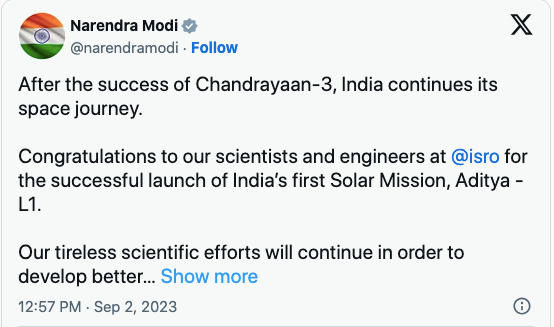
ISRO on Aditya L1 Launch
ISRO ensured the successful launch of Aditya L1 PSLV- C57 on 2 September 2023 by declaring the safe placement of vehicle into the orbit.
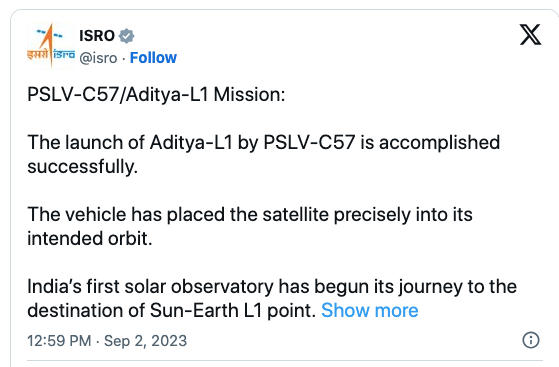
What is Aditya L1?
Aditya L1 is India’s first dedicated space-based solar mission, developed by the Indian Space Research Organisation (ISRO). The mission’s primary objective is to study the Sun, its outermost layer called the corona, and its associated phenomena. Named after the Hindu Sun god “Aditya,” the mission aims to gather crucial scientific data and insights about the Sun’s behavior and its impact on space weather and Earth’s environment.
The Aditya L1 spacecraft will be equipped with various instruments to observe the Sun in different wavelengths of light, allowing scientists to study its surface and corona with unprecedented detail. The mission’s focus includes investigating the Sun’s magnetic field dynamics, solar flares, and other solar activities that influence space weather and Earth’s climate.
One of the significant goals of the Aditya L1 mission is to understand the origins of the Sun’s corona, which is much hotter than its surface, and explore the mechanisms behind solar winds and their effects on Earth’s magnetosphere. This knowledge is essential for space weather prediction, which has implications for satellite operations, communication systems, and power grids on Earth.
Aditya L1 is a step towards enhancing India’s capabilities in space-based solar research and contributing to global scientific advancements in understanding our Sun and its influence on the solar system. Equipped with 7 payloads, the spacecraft will observe the Sun’s photosphere, chromosphere, and outermost layers of the sun. Below mentioned points below are as follows.
- The “Aditya” in the mission stands for the Sun in Sanskrit and the L1 stands for the Lagrange point 1 of the Sun-Earth system.
- Named after the Sanskrit word for Sun, the Aditya L1 Mission carries immense significance for both the Indian Space Research Organisation (ISRO) and the global scientific community.
- Aditya L1 is the first space-based observatory class Indian solar mission to study the Sun
- The Aditya L1 spacecraft is planned to be placed in a halo orbit around the Lagrangian point 1 (L1) of the Sun-Earth system, which is about 1.5 million km from the Earth.
- Aditya L1 will provide a greater advantage of observing solar activities continuously.
- Aditya L1 mission is poised to answer fundamental questions about the Sun’s behavior, magnetic fields, solar winds, and their impact on Earth’s climate and technology
- The Aditya-L1 satellite — named after the Sun God — will be carried by the Indian rocket Polar Satellite Launch Vehicle (PSLV).
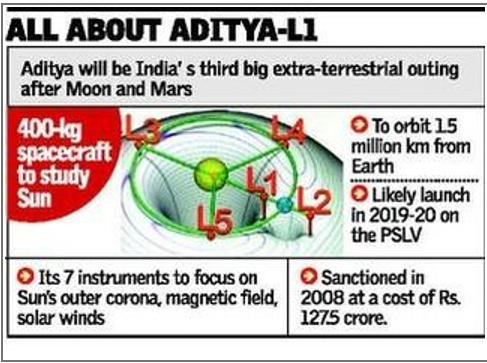
ADITYA L1 Mission Launch Date
The ADITYA L1 launched on 2 September 2023. ADITYA L1 marks India’s inaugural mission solely focused on observing the Sun, and it’s planned to be launched using a PSLV-XL launch vehicle on September 2, 2023.
- The Aditya L1 mission was originally scheduled for launch in the early 2020s, but due to various factors, including the COVID-19 pandemic, the launch timeline was pushed.
- ISRO Chairman S Somanath said the Aditya L1 satellite for the Sun mission is launched today on 2 September 2023.
- The ADITYA L1 Mission Launch Date and time of the is yet to be announced.
- The satellite realized at Bengaluru’s U R Rao Satellite Centre (URSC) has reached SDSC-SHAR, Sriharikota.
- The Aditya L1 spacecraft will be launched from the Sriharikota’s base.
ADITYA L1 Cost
The Cost of Aditya L1 in Indian rupees is Eight hundred twenty-five crore forty-eight lakh twenty-five thousand (8,25,48,25,000.00) which is $100 million (Estimated).
- Space exploration is a costly endeavor. The cost of launching an Aditya L1 spacecraft into orbit can be millions or even billions of dollars.
- This makes it important for space agencies to be cost-effective in their planning and execution of missions.
- The Aditya L1 mission is a cost-effective way for India to study the Sun.
- The total cost of the Aditya L1 mission is estimated to be around $100 million, which is a fraction of the cost of similar missions by other countries.
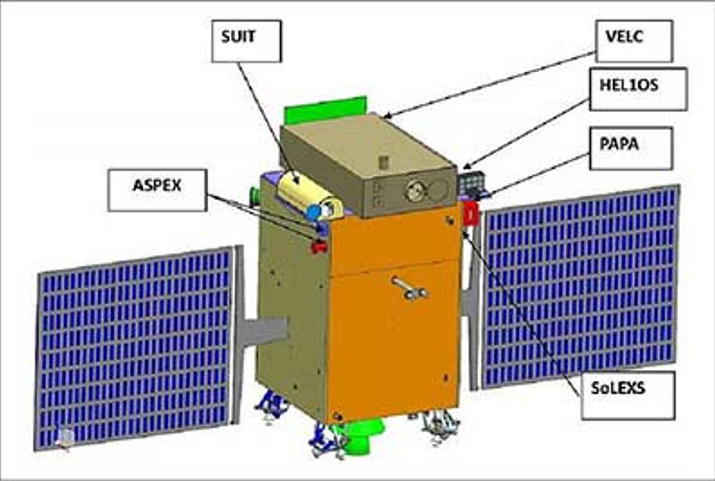
ADITYA-L1 Science Concepts and Payloads
- The Aditya-L1 mission carries a suit of seven scientific payloads to carry out a systematic study of the Sun
- The Visible Emission Line Coronagraph (VELC) studies the solar corona and dynamics of Coronal Mass Ejections.
- The Solar Ultra-violet Imaging Telescope (SUIT) payload images the Solar Photosphere and Chromosphere in near Ultra-violet (UV) and also measures the solar irradiance variations in near UV.
- The Aditya Solar Wind Particle Experiment (ASPEX) and Plasma Analyser Package for Aditya (PAPA) payloads study the solar wind and energetic ions, as well as their energy distribution.
- The Solar Low Energy X-ray Spectrometer (SoLEXS) and The High Energy L1 Orbiting X-ray Spectrometer (HEL1OS) study the X-ray flares from the Sun over a wide X-ray energy range.
- The Magnetometer payload is capable of measuring interplanetary magnetic fields at the L1 point.
- The science payloads of Aditya-L1 are indigenously developed by different laboratories in the country.
- The VELC instrument is developed at the Indian Institute of Astrophysics, Bangalore; the SUIT instrument at the Inter-University Centre for Astronomy & Astrophysics, Pune; the ASPEX instrument at the Physical Research Laboratory, Ahmedabad; the PAPA payload at Space Physics Laboratory, Vikram Sarabhai Space Centre, Thiruvananthapuram; SoLEXS and HEL1OS payloads at U R Rao Satellite Centre, Bangalore, and the Magnetometer payload at the Laboratory for Electro Optics Systems, Bangalore.
- All the payloads are developed with the close collaboration of various centers of ISRO
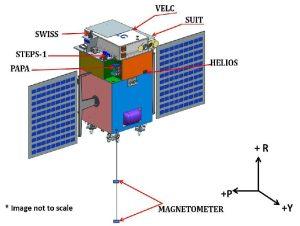
| Type | Sl. No. | Payload | Capability |
| Remote Sensing Payloads | 1 | Visible Emission Line Coronagraph(VELC) | Corona/Imaging & Spectroscopy |
| 2 | Solar Ultraviolet Imaging Telescope (SUIT) | Photosphere and Chromosphere Imaging- Narrow & Broadband | |
| 3 | Solar Low Energy X-ray Spectrometer (SoLEXS) | Soft X-ray spectrometer: Sun-as-a-star observation | |
| 4 | High Energy L1 Orbiting X-ray Spectrometer(HEL1OS) | Hard X-ray spectrometer: Sun-as-a-star observation | |
| In-situ Payloads | |||
| 5 | Aditya Solar Wind Particle Experiment(ASPEX) | Solar wind/Particle Analyzer Protons and heavier Ions with directions | |
| 6 | Plasma Analyser Package For Aditya (PAPA) | Solar wind/Particle Analyzer Electrons and heavier Ions with directions | |
| 7 | Advanced Tri-axial High-Resolution Digital Magnetometers | In-situ magnetic field (Bx, By and Bz). |
Is ADITYA-L1 a Complete Mission to Study the Sun?
- The obvious answer is a ‘NO’ which is not only true for Aditya-L1 but in general for any space mission.
- The reason is that due to the limited mass, power, and volume of the spacecraft that carries the scientific payloads in space, only a limited set of instruments with limited capacity can be sent onboard the spacecraft.
- In the case of Aditya-L1, all the measurements will be made from the Lagrange point L1. As an example, the various phenomena of the sun are multi-directional, and therefore the directional distribution of energy of explosive/eruptive phenomena will not be possible to study with Aditya-L1 alone.
- Another Lagrange point known as L5 is a good vantage point for studying the Earth-directed CME events and assessing the space weather. Also, the polar regions of the sun are not well studied due to the technological challenges of achieving spacecraft orbits for such studies.
- The sun’s polar dynamics and magnetic fields are believed to play an important role in deriving the solar cycles.
Further, the polarisation measurements of solar radiations at different wavelengths are required to understand the various processes occurring in and around the sun.
Watch More:
| Related Articles | |
| Moon Landing 2023 | Aditya L1 Mission |
| Chandrayaan-3 | Prime Minister Narendra Modi |

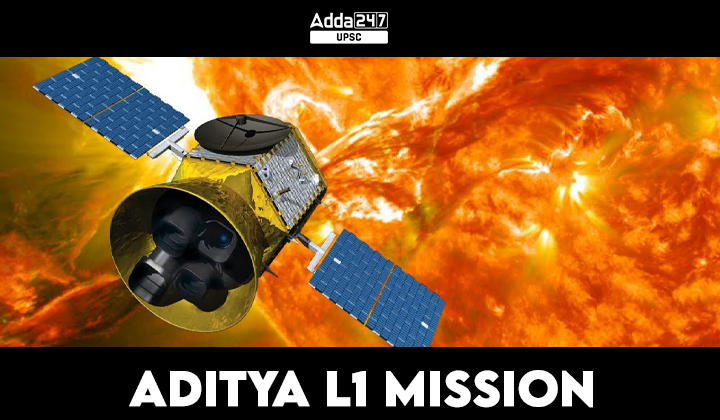
 TSPSC Group 1 Question Paper 2024, Downl...
TSPSC Group 1 Question Paper 2024, Downl...
 TSPSC Group 1 Answer key 2024 Out, Downl...
TSPSC Group 1 Answer key 2024 Out, Downl...
 Cabinet Ministers of India 2024, New Cab...
Cabinet Ministers of India 2024, New Cab...







